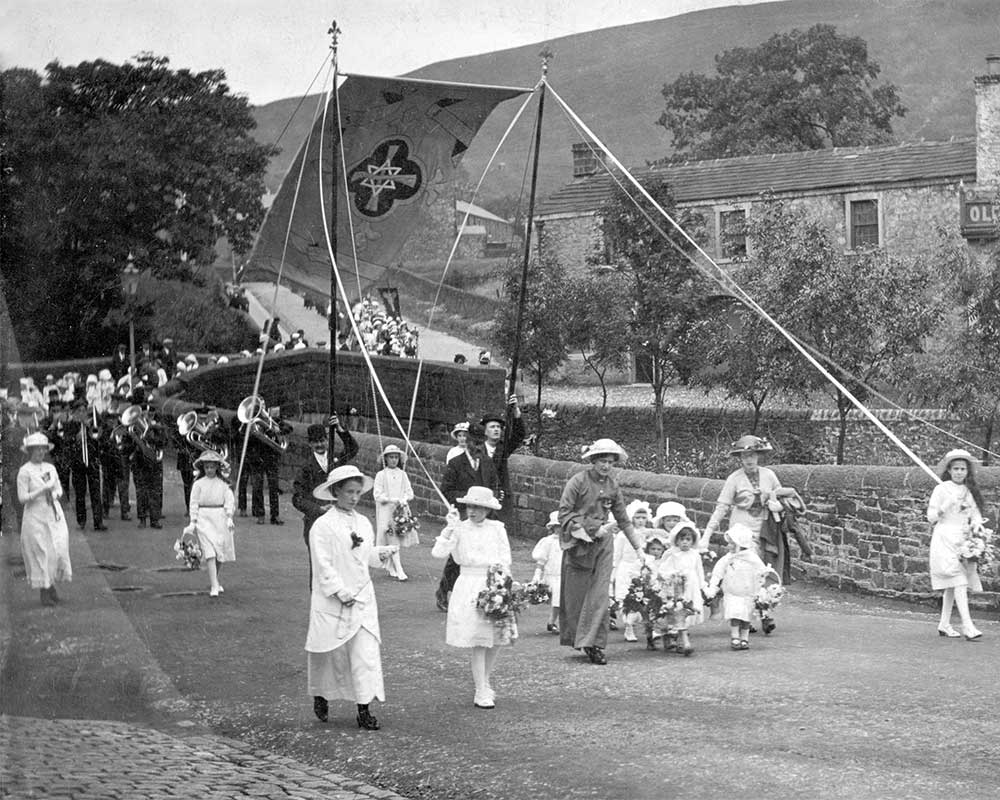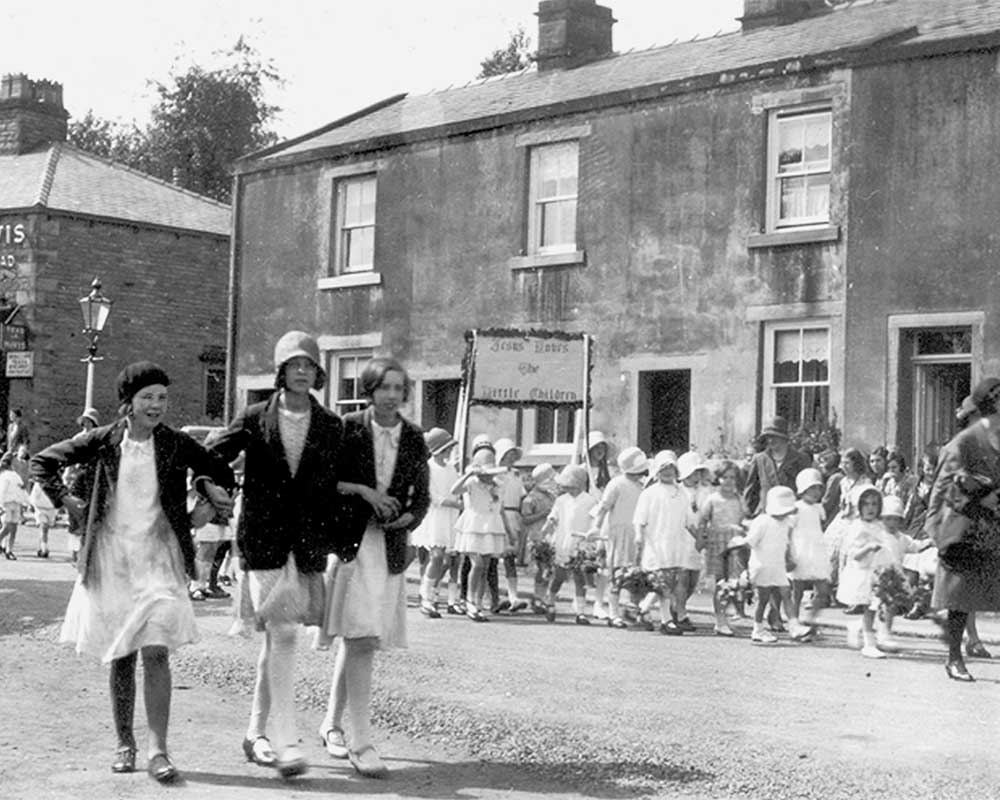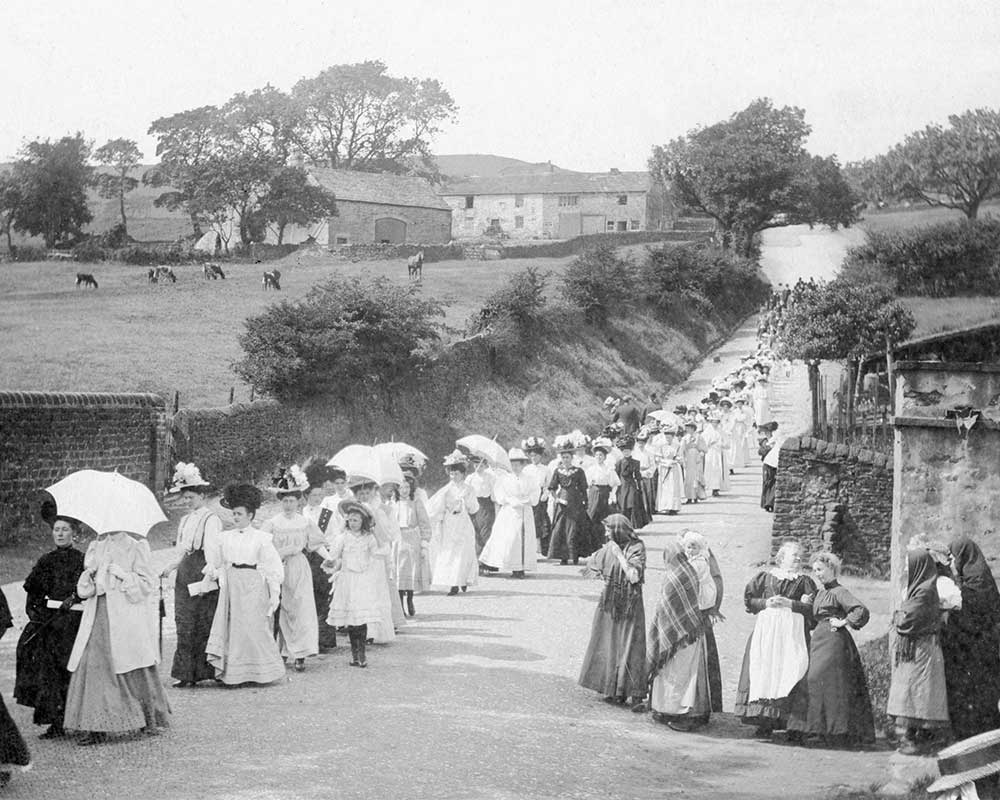Men working at the mills would typically wear a cloth cap, neckerchief, shirt, fustian trousers, waistcoat and clogs (fustian is thick, hard-wearing twilled cloth with a short nap).
Lancashire clogs – there were several types of clogs – pit clogs were like boots and came well above the ankle and were secured with natural leather laces. Toes were protected by a heavy steel plate. They had no decoration and were strictly for heavy work in a foundry or mill. Ordinary clogs for men were fastened with a clasp. Fred Green was a boot, shoe and clog maker who had a shop at 1 Whalley Road, Sabden.
Men saved their best clothes for church and special occasions and generally wore a 3 piece suit (jacket, trousers and waistcoat) with high, round collared white shirts, neckties and a bowler hat. Although some men sported beards, the clean -shaven look was popular – so was a bushy mustache.

Going to work in the early hours, women typically wore long skirts and blouses with an apron known as a ‘brat’ which almost reached the floor. The shawl was an integral part of a Lancashire mill town image, made of wool and generally dark in colour. Every clothier sold shawls. Shawls were large and warm and capable of covering the head and frequently kept in place at the chin by a large safety pin.
Women’s clogs were less substantial and were decorated all the way between the alder wood sole and the welt with brass tacks. A woman’s clog also had a strap across the instep.
Children’s clogs had a button for a fastener and the clog sometimes had more ornamentation with the half-inch broad toe piece of brass being a decorative touch.
There were even red clogs for babies. It was the only time that a departure from the traditional black was permitted.

Women did a lot of sewing, mending and darning and it was common to see boys with patched trousers and non-matching buttons.
Female mill workers would spend their money on clothes for special occasions, Sundays and holidays. Compare how girls looked going to work in the mills and how they looked on Saturday and Sunday and you would sometimes fail to recognise them. In the early 1900s women would wear skirts fitted over the hips and fluted towards the hem. Hair was worn under broad brim hats and adorned with flowers, lace, ribbons and feathers. Kid boots would be worn instead of clogs.
Free time could be taken up by hobbies such as writing letters to family and friends, going on walks, shopping or pursuing creative projects. The girls would often go on outings as groups, especially to church on Sunday. In 1900 more than half the population would attend church service on Sundays.
Traditionally Sabden Catholics would walk over Pendle Hill to attend St. Michael’s in Clitheroe. In the 1870s the Trappes family purchased land from the Fort family of Read and erected a building on Pendle Street East which served as both a chapel and a school and opened in 1877. Eventually Bank House on Whalley Road was purchased as the presbytery. With growing numbers a fund was set up and St. Mary’s Church was built on Whalley Road in 1937 using stone from a disused mill in Oldham.
The original Baptist Chapel was opened in 1797 and cost £400 inside a square of houses where most of Sabden inhabitants lived at that time boundered by Top Row, Bury Row and Step Row. The graveyard is still used but after 113 years the building was demolished and a new Baptist Church was built at the bottom of Clitheroe Road in 1910. Many did not like the idea of pulling down the old chapel but many of the congregation found the pull up the hill to services a factor plus the distance from the centre of the village. Great sacrifices were made by the congregation to raise the estimated £6500 cost of the new building. Over time church attendance became low and income did not cover expenditure and this building became too large. In 1986 the decision was made to sell the chapel building as a private dwelling and since then the former Sunday School building has been used for services.

In 1835 a new Baptist group was founded and named themselves the ‘Particular Baptists’ and set themselves apart from the ‘General Baptists’. They followed the beliefs of John Calvin. They first met in a house on Step Row until their numbers grew over the next two years to warrant the building of premises. The accommodation consisted of two cottages and a shop on Whalley Road and the shop was designated as a meeting room. This small chapel was built in 1837 but worship came to an end in 1848. The building still stands on Whalley Road divided into two houses but shows no outward evidence of its previous existence.
Methodism was introduced to Sabden in 1766 but it wasn’t until 1835 that the first Methodist Chapel was opened seating 150 people. A 350 seater chapel with a school building opened in 1848 and a third chapel for 500 people was opened in 1879 on Wesley Street. This survived until 1965 when it had to be demolished due to dry rot which made the building unsafe. Subsequently a room in the school was converted into a chapel. The Methodist Church closed in 2008 and the building is now a private dwelling with the graveyard still sited in the grounds.
St Nicholas and Heyhouses church which is grade II listed, was built in 1841 and consecrated to St Simons and St Jude. 5 years later in 1846 it was consecrated to St Nicholas. It houses a rare John Laycock organ which was built in 1879 and is considered ‘ an instrument of importance to the national heritage and one deserving careful preservation for the benefit of future generations’. St Nicholas is one of the few churches in Lancashire to maintain a Rose Queen, a tradition which started in 1949.
A North of England tradition, Walking Day has long been a Sabden tradition. Taking place at Whitsuntide, each church and chapel would parade through the streets with banners with a brass band playing as an act of Christian witness. The procession stopped off at certain places around the village for a prayer or to sing a hymn. Villagers who weren’t in the procession were usually watching. This was often an occasion for new clothes.
The photographs show Walking Day at different times through the last century.
